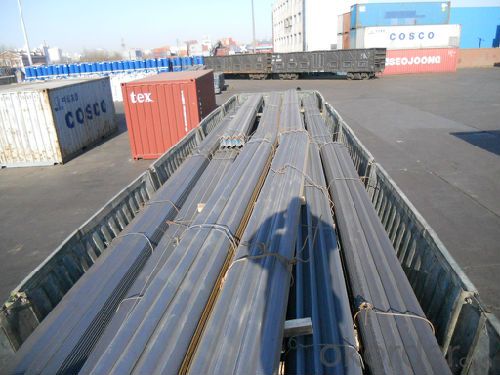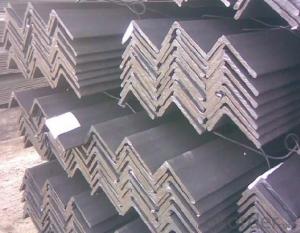GB Q345 Steel Angle with High Quality 75*75mm
- Loading Port:
- Tianjin
- Payment Terms:
- TT or LC
- Min Order Qty:
- 25 m.t
- Supply Capability:
- 10000 m.t/month
OKorder Service Pledge
OKorder Financial Service
You Might Also Like
Specifications of GB Q345 Steel Angle with High Quality 75*75mm:
1.Standards: GB
2.Material: Q345 or Equivalent
3.Length: 6m, 12m
4.Size:
| Size (mm) | Mass (kg/m) | Size (mm) | Mass (kg/m) |
| 75*75*6 | 6.905 | 75*75*8 | 9.030 |
| 75*75*7 | 7.976 |
Usage & Applications of GB Q345 Steel Angle with High Quality 75*75mm:
Trusses;
Transmission towers;
Telecommunication towers;
Bracing for general structures;
Stiffeners in structural use.
Packaging & Delivery of GB Q345 Steel Angle with High Quality 75*75mm:
1. Transportation: the goods are delivered by truck from mill to loading port, the maximum quantity can be loaded is around 40MTs by each truck. If the order quantity cannot reach the full truck loaded, the transportation cost per ton will be little higher than full load.
2. With bundles and load in 20 feet/40 feet container, or by bulk cargo, also we could do as customer's request.
3. Marks:
Color mark: There will be color marking on both end of the bundle for the cargo delivered by bulk vessel. That makes it easily to distinguish at the destination port.
Tag mark: There will be tag mark tied up on the bundles. The information usually including supplier logo and name, product name, made in China, shipping marks and other information request by the customer.
If loading by container the marking is not needed, but we will prepare it as customers' request.
FAQ:
Q1: Why buy Materials & Equipment from OKorder.com?
A1: All products offered byOKorder.com are carefully selected from China's most reliable manufacturing enterprises. Through its ISO certifications, OKorder.com adheres to the highest standards and a commitment to supply chain safety and customer satisfaction.
Q2: How do we guarantee the quality of our products?
A2: We have established an advanced quality management system which conducts strict quality tests at every step, from raw materials to the final product. At the same time, we provide extensive follow-up service assurances as required.
Q3: How soon can we receive the product after purchase?
A3: Within three days of placing an order, we will arrange production. The shipping date is dependent upon the quatity, how many sizes you want and the plan of production, but is typically 30 to 45 days from the beginning of production.
Images of GB Q345 Steel Angle with High Quality 75*75mm:


*If you would like to get our price, please inform us the size, standard/material and quantity. Thank you very much for your attention.
- Q:Can steel angles be used for transmission towers?
- Yes, steel angles can be used for transmission towers. Steel angles are commonly used in the construction industry for various structural applications, including transmission towers. They provide excellent strength and stability, making them suitable for supporting heavy loads and withstanding the rigors of outdoor environments. Steel angles can be easily fabricated, welded, and bolted together to form the required shapes and configurations for transmission towers. Additionally, they offer good corrosion resistance, which is crucial for structures exposed to weather conditions. Overall, steel angles are a popular and reliable choice for transmission tower construction.
- Q:Can steel angles be used for framing or supporting mezzanines or elevated platforms?
- Yes, steel angles can be used for framing or supporting mezzanines or elevated platforms. Steel angles are commonly used in construction projects for their structural strength and versatility. They are often used as supports or braces in various applications, including framing mezzanines or elevated platforms. Steel angles provide stability and structural integrity, making them an ideal choice for supporting heavy loads and creating a robust framework. Their L-shaped design allows for easy installation and provides excellent resistance against bending and shearing forces. Additionally, steel angles can be easily welded or bolted together, offering flexibility in design and construction. Overall, steel angles are a reliable and effective choice for framing or supporting mezzanines or elevated platforms.
- Q:What is the maximum slope for a steel angle?
- The maximum slope for a steel angle depends on various factors such as the size, shape, and thickness of the angle. However, in general, steel angles are designed to withstand vertical loads and provide stability in structural applications. Therefore, the maximum slope for a steel angle is typically limited to angles less than 45 degrees. Going beyond this angle may compromise the structural integrity of the angle and increase the risk of failure. It is important to consult engineering codes, standards, and specifications to determine the specific maximum slope for a particular steel angle in a given application.
- Q:Can steel angles be used for framing partitions and walls?
- Indeed, framing partitions and walls can be accomplished by utilizing steel angles. In construction, steel angles are extensively employed due to their robustness and longevity. A framework for partitions and walls can be established by employing steel angles, which offer structural reinforcement and stability. Steel angles possess adaptability, enabling them to be effortlessly cut and welded to fit desired dimensions and angles. Moreover, they exhibit resistance to fire, pests, and moisture, rendering them an ideal selection for framing interior walls and partitions in both commercial and residential structures.
- Q:Can steel angles be used for platform structures?
- Indeed, platform structures can utilize steel angles. Due to their strength, durability, and versatility, steel angles find frequent application in the construction field. They impart structural support and stability to diverse platform types, such as elevated walkways, mezzanines, catwalks, and scaffolding. With exceptional load-bearing capacity, steel angles endure heavy loads, rendering them apt for platform structures necessitating robustness and stability. Furthermore, the seamless fabrication and assembly of steel angles enable efficient construction and customization of platform structures.
- Q:Are steel angles suitable for architectural sculptures or installations?
- Yes, steel angles are suitable for architectural sculptures or installations due to their versatility, strength, and structural integrity. They can be easily shaped and welded to create intricate designs and support heavy structures, making them a popular choice for artistic and functional installations in architecture.
- Q:Can steel angles be used in the construction of transmission line towers?
- Yes, steel angles can be used in the construction of transmission line towers. Steel angles are commonly used as structural members in tower construction due to their strength, durability, and cost-effectiveness. They provide stability and support to the tower structure, making them an ideal choice for transmission line tower construction.
- Q:What is the typical yield stress of steel angles?
- The typical yield stress of steel angles can vary depending on the specific grade and type of steel being used. However, for commonly used carbon steels, the typical yield stress ranges from 36,000 to 50,000 pounds per square inch (psi). This means that the steel angles can withstand a certain amount of stress or pressure before they begin to deform or permanently change shape. It is important to note that different steel alloys and treatments can result in varying yield stresses, so it is necessary to consult the specific specifications or reference materials for the particular steel angle in question.
- Q:Are steel angles resistant to wind loads?
- Yes, steel angles are resistant to wind loads. Steel angles are commonly used in construction for their strength and stability. When properly designed and installed, steel angles provide structural support and can effectively resist the forces exerted by wind. The shape and geometry of steel angles provide rigidity and stability, making them capable of withstanding wind loads without significant deformation or failure. Additionally, steel angles can be reinforced and connected to other structural elements, further enhancing their resistance to wind loads.
- Q:What is the maximum allowable torsional buckling stress for a steel angle?
- The maximum allowable torsional buckling stress for a steel angle depends on various factors such as the material properties, angle dimensions, and the specific design code or standard being followed. Therefore, without specific information, it is not possible to provide a definitive answer. It is recommended to consult the relevant design code or a structural engineer to determine the maximum allowable torsional buckling stress for a steel angle.
1. Manufacturer Overview |
|
|---|---|
| Location | |
| Year Established | |
| Annual Output Value | |
| Main Markets | |
| Company Certifications | |
2. Manufacturer Certificates |
|
|---|---|
| a) Certification Name | |
| Range | |
| Reference | |
| Validity Period | |
3. Manufacturer Capability |
|
|---|---|
| a)Trade Capacity | |
| Nearest Port | |
| Export Percentage | |
| No.of Employees in Trade Department | |
| Language Spoken: | |
| b)Factory Information | |
| Factory Size: | |
| No. of Production Lines | |
| Contract Manufacturing | |
| Product Price Range | |
Send your message to us
GB Q345 Steel Angle with High Quality 75*75mm
- Loading Port:
- Tianjin
- Payment Terms:
- TT or LC
- Min Order Qty:
- 25 m.t
- Supply Capability:
- 10000 m.t/month
OKorder Service Pledge
OKorder Financial Service
Similar products
New products
Hot products
Related keywords



























